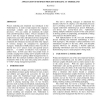Free Online Productivity Tools
i2Speak
i2Symbol
i2OCR
iTex2Img
iWeb2Print
iWeb2Shot
i2Type
iPdf2Split
iPdf2Merge
i2Bopomofo
i2Arabic
i2Style
i2Image
i2PDF
iLatex2Rtf
Sci2ools
WSC
1998
1998
Application of Business Process Modeling at Timberland
Process modeling and simulation was introduced to the Timberland Co. in order to help improve the company's increasingly complex and cross-functional business processes. Two case studies are mentioned, the sample room and EDI purchase orders. Process simulation was able to show the impact of different resource levels on sample room cycle times and helped convince management to hire additional staff to meet anticipated demand. The simulation also illustrated second and third order impacts of resource changes not anticipated by experienced managers. Simulation of EDI purchase orders was able to identify key "as-is" process issues and quantify process behavior. A number of initiatives were launched to address these. In both cases there were people issues to consider, ranging from training staff to properly build and analyze simulations to getting middle-management buy in. Results show the technical usefulness and power of good simulations while at the same time paying clos...
| Added | 01 Nov 2010 |
| Updated | 01 Nov 2010 |
| Type | Conference |
| Year | 1998 |
| Where | WSC |
| Authors | Dan Grosz |
Comments (0)

